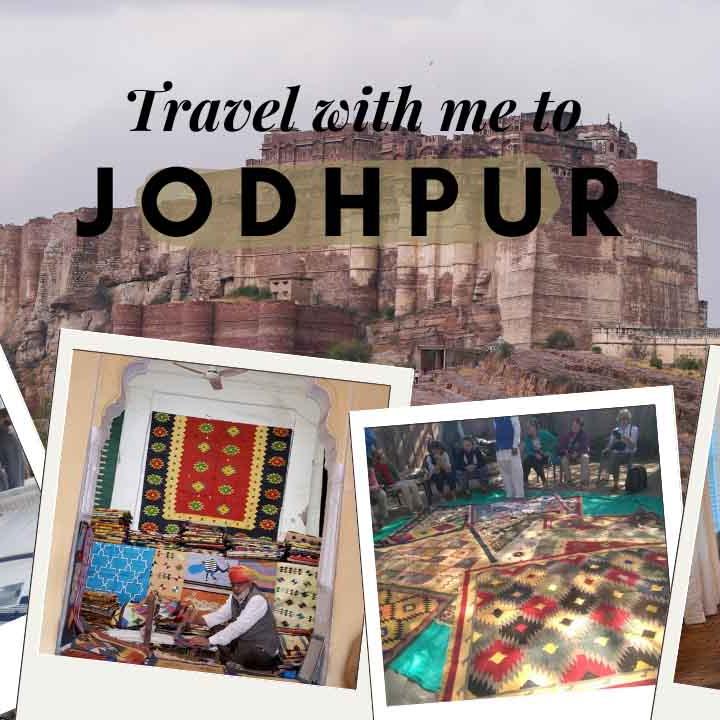
Exploring Jodhpur's Rich Heritage: The Art of Durry Weaving at Salawas Durry Udyog
Exploring Jodhpur's Rich Heritage: The Art of Durry Weaving at Salawas Durry Udyog
Welcome to the enchanting city of Jodhpur, where every corner whispers tales of its vibrant heritage! Nestled amidst the golden sands and timeless forts lies Salawas, a quaint village renowned for a unique craft that has woven itself into the very fabric of Rajasthani culture: durry weaving. In this blog post, we invite you on an immersive journey to explore the rich tapestry of traditions at Salawas Durry Udyog. From intricate patterns to vivid colors, discover how skilled artisans breathe life into wool and cotton threads, creating stunning rugs that are not just floor coverings but masterpieces steeped in history. Join us as we unravel the art behind these exquisite creations and uncover the stories that make Jodhpur's heritage truly exceptional!
Welcome to the vibrant heart of Rajasthan, where the desert sands meet a tapestry of tradition! In this blog post, we invite you on an enchanting journey to Jodhpur, the Blue City renowned for its majestic forts and palaces. But beyond the iconic Mehrangarh Fort and bustling markets lies a hidden gem: Salawas Durry Udyog. Here, amidst the soothing rhythm of looms and colorful threads, skilled artisans breathe life into age-old techniques through the exquisite craft of durry weaving. Join us as we delve deep into Jodhpur’s rich heritage, uncovering stories woven in every strand and celebrating a timeless art that not only adorns homes but also preserves cultural legacies. Let’s explore how these intricate floor coverings transform simple spaces into vibrant expressions of history and craftsmanship!
Introduction to Jodhpur and its rich heritage
Nestled in the heart of Rajasthan, Jodhpur is a city that boasts an enchanting blend of vibrant culture and rich heritage. Known as the "Blue City" for its stunning indigo-hued buildings, it offers visitors a unique glimpse into traditional Indian craftsmanship. Among the many artistic treasures this city holds, one stands out prominently: Durry weaving. This ancient craft not only showcases intricate patterns but also tells stories passed down through generations.
At Salawas Durry Udyog, you can experience this art form firsthand. The weavers here dedicate their lives to creating beautiful hand-woven rugs that reflect both cultural significance and aesthetic beauty. Each piece carries with it a legacy steeped in history and tradition, making them much more than just decorative items; they are windows into Jodhpur's past.
Join us on this journey as we explore the fascinating world of Durry weaving at Salawas Durry Udyog—a place where creativity meets sustainability and community spirit flourishes amidst vibrant threads!
Introduction to Jodhpur and its rich heritage:
Jodhpur, also known as the "Blue City" or "Sun City", is a charming city located in the state of Rajasthan in India. It is famous for its majestic forts, vibrant culture, and rich history. Jodhpur has been ruled by various dynasties like the Rajputs, Mughals, and Marathas, which have left a significant mark on its cultural heritage.
The city was founded in 1459 AD by Rao Jodha of the Rathore clan. It is situated at the edge of Thar Desert and is surrounded by rocky hills that give it a striking blue backdrop. The blue color of houses in the old city area gives it the nickname "Blue City". This color was traditionally used to indicate that a house belonged to a Brahmin (priest) family but now it has become an iconic symbol of Jodhpur's beauty.
Jodhpur's rich heritage can be seen in every aspect - from its architecture and handicrafts to its food and festivals. The city is home to some magnificent palaces, forts, temples, and havelis (traditional mansions), which are architectural masterpieces reflecting the grandeur of Rajput rulers. Some must-visit places include Mehrangarh Fort - one of the largest forts in India, Umaid Bhawan Palace - an opulent palace turned into a luxury hotel, Jaswant Thada - a cenotaph built-in honor of Maharaja Jaswant Singh II, and Mandore Gardens - known for its ancient Hindu temples.
Apart from these historical monuments, Jodhpur is also renowned for its traditional crafts such as bandhani (tie-dye), leatherwork, pottery making, jewelry making, block printing and most importantly Durry weaving. Durries are traditional hand-woven rugs made from cotton or wool threads using a shuttle loom. They are an essential part of Rajasthani culture and can be seen in almost every household.
One of the best places to witness the art of Durry weaving is Salawas Durry Udyog - a family-run business located in Salawas village, about 20 km from Jodhpur. This place is not just a factory but also a museum that showcases the history and process of durry making. Visitors can interact with skilled weavers, watch them at work, and even try their hand at weaving.
Jodhpur's rich heritage is what makes it a unique and fascinating destination for travelers from all over the world. From its historical landmarks to its traditional crafts, this city has something for everyone to explore and appreciate. And there's no better way to immerse yourself in Jodhpur's heritage than by experiencing the intricate art of Durry weaving at Salawas Durry Udyog.
History of Durry Weaving in Jodhpur
Durry weaving in Jodhpur boasts a legacy that dates back centuries. This traditional craft has its roots intertwined with the nomadic tribes of Rajasthan, particularly the Bishnoi community. They initially created these vibrant rugs for practical purposes, using them as bedding and floor coverings.
As Jodhpur evolved into a thriving trade hub, artisans began to experiment with designs and colors. The unique patterns reflected the rich culture and heritage of the region, making each piece distinctively beautiful.
Many families passed down this skill through generations, ensuring that it remained an integral part of local identity. Over time, Durries transformed from mere utility items into exquisite pieces of art cherished by collectors worldwide.
The intertwining stories of craftsmanship and cultural significance continue to shape the narrative around Durry weaving today. Each rug tells a tale—a testament to patience, artistry, and tradition handed down through ages.
The significance of Salawas Durry Udyog in preserving the art of Durry weaving
Salawas Durry Udyog stands as a beacon of tradition in Jodhpur. This establishment plays a crucial role in keeping the ancient craft of durry weaving alive. With generations of knowledge, skilled artisans weave vibrant stories into each piece.
The workshop is more than just a production unit; it’s a cultural haven where age-old techniques are passed down through families. Every thread tells tales of heritage and craftsmanship that date back centuries.
By maintaining these practices, Salawas Durry Udyog not only celebrates history but also supports its local community. The weavers take immense pride in their work, knowing they contribute to something greater than themselves.
Visitors can witness this artistry firsthand, experiencing the dedication involved in crafting beautiful durries. Each creation embodies the spirit of Rajasthan—a harmonious blend of history and innovation that continues to thrive amidst modern influences.
Step-by-step process of Durry weaving at Salawas Durry Udyog
At Salawas Durry Udyog, the weaving process begins with selecting high-quality wool. This natural material is dyed using vibrant colors derived from plants and minerals. The artisans pay close attention to color combinations that reflect both tradition and personal creativity.
Next comes the preparation of the loom. Each weaver meticulously sets up their space, ensuring everything is in place for a seamless workflow. With deft hands, they start threading the warp—vertical strands that form the foundation of every durry.
The real magic happens as they weave intricate patterns into each piece. Using traditional techniques passed down through generations, artisans blend artistry with skillful craftsmanship.
As rows of colorful designs emerge, each durry tells a unique story—a reflection of Jodhpur’s rich cultural tapestry. The final steps involve trimming edges and finishing touches before these beautiful pieces are ready to be cherished by buyers around the world.
Unique designs and patterns found in Salawas Durries
Salawas Durries are a vibrant tapestry of creativity and tradition. Each piece tells a story through its intricate designs. You’ll find geometric patterns that echo the rich heritage of Rajasthan, showcasing both symmetry and artistry.
Floral motifs flourish in various colors, celebrating nature’s beauty. These designs often reflect local flora, connecting each rug to its cultural roots.
Bold hues like deep reds, bright yellows, and striking blues dominate the landscape of these durries. The color combinations evoke warmth and invite admiration.
Beyond aesthetics, every pattern holds significance—some symbolize protection or prosperity in local folklore. It’s not just a carpet; it’s woven history underfoot.
The artisans pour their heart into every stitch, ensuring that each design is unique yet quintessentially Salawas. Whether you choose contemporary styles or traditional looks, there’s an allure that makes these durries truly special.
Materials used for making Durries and their sustainability practices
Durries from Salawas are crafted using natural materials that reflect the region's heritage. Cotton is often the primary fiber, appreciated for its durability and comfort. Wool also plays a significant role, providing warmth and texture to the rugs.
Sustainability is at the heart of Durry weaving practices here. Artisans prioritize eco-friendly methods by sourcing locally grown fibers. This not only reduces transportation emissions but also supports local farmers.
Additionally, traditional dyeing techniques are used to color the yarns. These dyes often come from plants and minerals, ensuring minimal environmental impact compared to synthetic alternatives.
Every step in creating these Durries emphasizes respect for nature. The weavers aim to maintain a balance between artistry and ecological responsibility while preserving their cultural legacy through sustainable craftsmanship.
Shopping experience at Salawas Durry Udyog - buying authentic hand-woven Durries directly from the weavers
Visiting Salawas Durry Udyog is like stepping into a vibrant tapestry of culture and craftsmanship. As you enter, the air buzzes with creativity. Weavers focus intently on their looms, each thread telling a story.
Here, shopping becomes an immersive experience. You’re not just buying a durry; you’re acquiring a piece of art that carries the spirit of Jodhpur’s heritage. Each rug reflects hours of hard work and dedication from skilled artisans who take pride in their craft.
Engaging directly with these weavers adds depth to your purchase. They share their techniques, inspirations, and the traditions passed down through generations. This connection transforms your transaction into something meaningful.
The variety is mesmerizing—each design unique to its creator. Bright colors dance across every piece, inviting you to explore patterns that resonate personally with you. Walking away with an authentic hand-woven durry means taking home more than just decor; it symbolizes support for local talent and age-old traditions.
Impact of Salawas Durry Udyog on the local community and economy
Salawas Durry Udyog has become a vital lifeline for the local community. It offers employment opportunities to many artisans, ensuring their traditional skills are not lost to time.
The weaving center supports families financially, empowering them to invest in education and health. As these artisans create stunning durries, they also pass on their craft to younger generations. This transfer of knowledge keeps the cultural heritage alive.
Moreover, increased tourism brings attention and resources into the area. Visitors come seeking authentic experiences and leave with unique pieces of art that tell stories of tradition.
Local vendors benefit from this influx as well, creating a symbiotic relationship between craftspeople and traders in Jodhpur. The economic ripple effect is felt far beyond Salawas itself, fostering prosperity throughout the region while celebrating its rich history.
Promoting cultural tourism through the art of Durry weaving at Salaw




